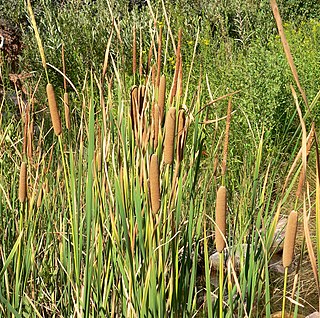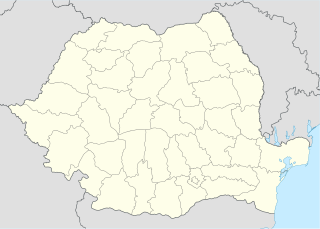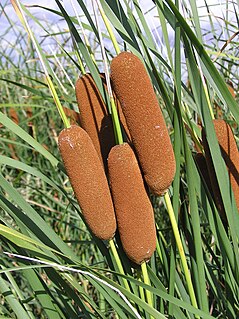
Typha is a genus of about 30 species of monocotyledonous flowering plants in the family Typhaceae. These plants have a variety of common names, in British English as bulrush or reedmace, in American English as reed, cattail, or punks, in Australia as cumbungi or bulrush, in Canada as bulrush or cattail, and in New Zealand as raupo. Other taxa of plants may be known as bulrush, including some sedges in Scirpus and related genera.

Astrakhan, is the largest city and administrative centre of Astrakhan Oblast in Southern Russia. The city lies on two banks of the Volga, in the upper part of the Volga Delta, on eleven islands of the Caspian Depression, 60 miles from the Caspian Sea, with a population of over 529,739 residents. At an elevation of 28 meters (92 ft) below sea level, it is the lowest city in Russia.

Typha latifolia is a perennial herbaceous plant in the genus Typha. It is found as a native plant species in North and South America, Europe, Eurasia, and Africa. In Canada, broadleaf cattail occurs in all provinces and also in the Yukon and Northwest Territories, and in the United States, it is native to all states except Hawaii. It is an introduced and invasive species, and is considered a noxious weed, in Australia and Hawaii. It has been reported in Indonesia, Malaysia, New Zealand, Papua New Guinea, and the Philippines.

Typha angustifolia L. is a perennial herbaceous plant of genus Typha. This cattail is an "obligate wetland" species that is commonly found in the northern hemisphere in brackish locations.

Calamotropha paludella is a species of moth of the family Crambidae. It is found in Europe, Africa, Australia and large parts of Asia.

Typha domingensis, known commonly as southern cattail or cumbungi, is a perennial herbaceous plant of the genus Typha.

The bulrush wainscot is a moth of the family Noctuidae. It is found from Ireland and Portugal to southern Fennoscandia, east to western Siberia, the Altai Mountains, Yakutia, Turkey, the Caucasus, Lebanon, Egypt, Arabia, Iraq, Iran, Afghanistan and Central Asia.
Carinomitra typha is a species of sea snail, a marine gastropod mollusk in the family Mitridae, the miters or miter snails.

Lower Silvermine Wetlands is a nature reserve on the Cape Peninsula, in Cape Town, South Africa.

The shy cosmet moth is a moth of the family Cosmopterigidae. It is known from all of Europe, as well as Asia, Australia and New Zealand. It is also present in North America, where it is distributed from Nova Scotia to Virginia, west to Oklahoma and north to Ontario. The habitat consists of fens and marshes.

Astrakhan Nature Reserve is a Russian 'zapovednik' covering an area including the islands and wetlands of the Volga Delta, where the Volga River enters the northwest sector of the Caspian Sea. The landscape is one of extensive reeds, cattails and willows and is an important nesting area for waterfowl and wading birds. The areas is rich in fish, with 50 species recorded, including beluga sturgeon. The reserve is situated in the Ikryaninsky District of Astrakhan Oblast. Since 1975, the territory has been part of a Ramsar wetlands site of international importance, and since 1984 it has been included in the World Network of Biosphere Reserves.

Typha orientalis, commonly known as bulrush or cumbungi, is a perennial herbaceous plant in the genus Typha. It is native to Australia, New Zealand, Malaysia, Indonesia, Japan, Korea, Mongolia, Myanmar, Philippines, China and the Russian Far East.

Cehei Pond Nature Reserve is situated in north-western Romania, in Crasna river floodplain, in Sălaj County and is a protected area with aquatic vegetation and fauna specific to such area.

Bulrushes is the vernacular name for several large wetland grass-like plants in the sedge family (Cyperaceae).

Typha laxmannii, common name graceful cattail, is a wetland plant species widespread across Europe and Asia. Typha laxmannii is not as tall as many of the other species in the genus, rarely more than 130 cm high. A noticeable space separates the staminate (male) flowers from the pistillate (female) ones.

Typha capensis is an aquatic plant known from southern and eastern Africa as far north as Uganda. It has also been reported from Brazil.
Typha shuttleworthii is a species of cattail found in southern Europe as well as in Iran and Turkey.
Typha elephantina is a plant species widespread across northern Africa and southern Asia. It is considered native in Algeria, Egypt, Libya, Mauritania, Senegal, Chad, Eritrea, Ethiopia, Turkmenistan, Tajikistan, Uzbekistan, Palestine, Israel, Saudi Arabia, Yemen, Yunnan, Assam, Bangladesh, India, Bhutan, Nepal, Pakistan and Burma. It grows in freshwater marshes and on the banks of lakes and streams.
Typha × provincialis is a plant of hybrid origin, endemic to southern France. Type collection was obtained from near St. Tropez in Provence. It apparently originated as a cross between the two very widespread species T. domingensis and T. latifolia.Typha × provincialis grows in freshwater marshes.
Typha × gezei is a plant of hybrid origin, endemic to France. It apparently originated as a cross between the two very widespread species T. domingensis and T. angustifolia.Typha × gezei grows in freshwater marshes.














